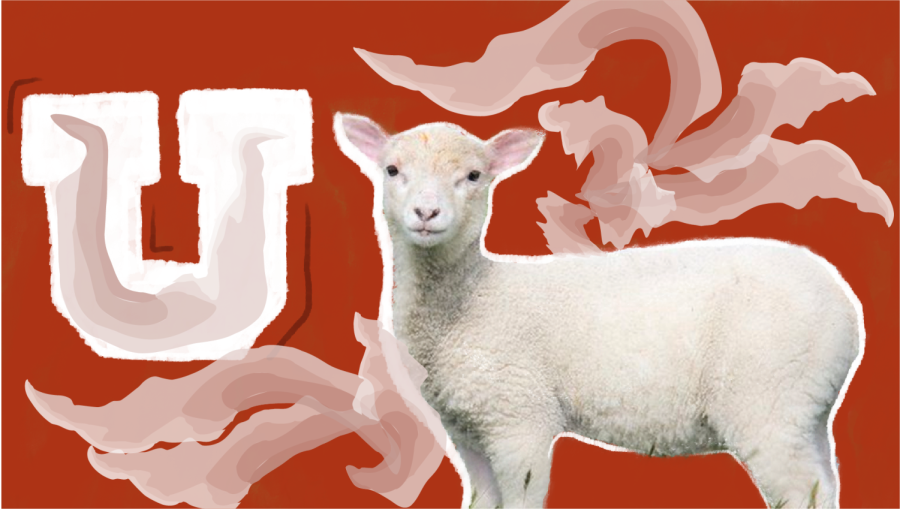Escaped Lamb Joins the Ranks of Wildlife on Campus
(Graphic by Storey McDonald | The Daily Utah Chronicle)
October 17, 2021
Though it is not rare to spot wildlife on the University of Utah’s campus, it is rare to see barnyard animals such as sheep. Much to the bewilderment of University of Utah professor Avery Holton, chair of the communications department and editorial advisor to The Daily Utah Chronicle, a lost lamb was spotted outside of his office window.
“It was a little surprising,” Holton said, speaking in his capacity as chair. “We didn’t really know where [the lamb] came from at the time. I think more than anything, we just wanted to make sure that it was safe and secure and that it didn’t hurt itself running into traffic or something or someone.”
Holton described the moment he spotted the lamb from inside his office.
“An hour or so before noon I was having a meeting with a colleague,” Holton said. “My colleague said, ‘Oh look at that dog,’ and I was like, ‘That isn’t a dog, that is a sheep.’”
Holton and his colleague then went to investigate the lost lamb, which at this point was drawing a crowd.
“We did call campus police and animal control, and both of them showed up within about 30 minutes,” Holton said. “[They] tried to corral the sheep in the corner, and it was having none of it. It, sort of, just bounded right past them and took off, at least for us, to never be seen again.”
The lamb, nicknamed the “Ewe of U” by some, was meant to be delivered to the James L. Sorenson Molecular Biotechnology Building to aid in the research of infectious diseases.
“The lamb was able to slip past its handlers while being offloaded from a transportation vehicle,” said University of Utah Spokesman Shawn Wood in an interview via email. “We should note that it was late at night/early in the morning and dark out, making immediate location and capture of the lamb difficult.”
The ewe was eventually caught but had suffered from the effects of being outside for so long.
“About a week ago the lamb was seen near Emigration Canyon and was successfully rescued and taken to the Salt Lake City Animal Services facility,” Wood said. “However, shortly after arriving the lamb passed away. It’s thought that dehydration and malnutrition from being outside without care were contributing factors.”
The lamb joins a zoo of other animals that have wandered onto and around campus.
“With campus being so close to the foothills of the Wasatch mountains, seeing wildlife such as deer can be quite frequent,” Wood said. “It’s the University of Utah’s policy to notify campus in a timely manner when animals are reported on campus that could present a clear and present danger. Animals like coyotes, mountain lions and larger aggressive animals like moose fit within this category. Depending on the animal, the U partners with Animal Services in Salt Lake City and/or the Utah Division of Wildlife Resources to safely capture and release the animal back into the wild.”
According to the Conservation Outreach Manager of the Utah Division of Wildlife Resources Scott Root, animals have myriad reasons to venture onto campus.
“If it’s wintertime, a lot of animals will migrate downward closer to town,” Root said. “They like to be on south-facing slopes where the sun has melted off some of the vegetation. In the summer, they’re looking for water, and if it’s not up there, they may end up in town looking for lush vegetation or water sources.”
According to Root, students should keep their distance, but do not need to worry about deer or coyotes on campus.
“For students on campus, a coyote typically won’t be too aggressive, they’ll probably walk or run off if they get spooked,” Root said. “Make a lot of noise, raise your arms if you’re afraid.”
Additionally, students should report sightings of moose, coyotes or mountain lions on campus.
“We want to know about a mountain lion,” Root said. “Keep your distance, don’t run, wave your arms to appear bigger [and] make a lot of noise. More often than not, that mountain lion has no interest in encountering a human.”
To report campus wildlife sightings, contact campus police at (801) 585-2677 or the Utah Division of Wildlife Resources at (801) 538-4700.
Editor’s note: As previously noted, Avery Holton is both the editorial advisor for The Daily Utah Chronicle and a professor at the University of Utah. As he was interviewed for this piece, Holton did not offer advice for this article.









